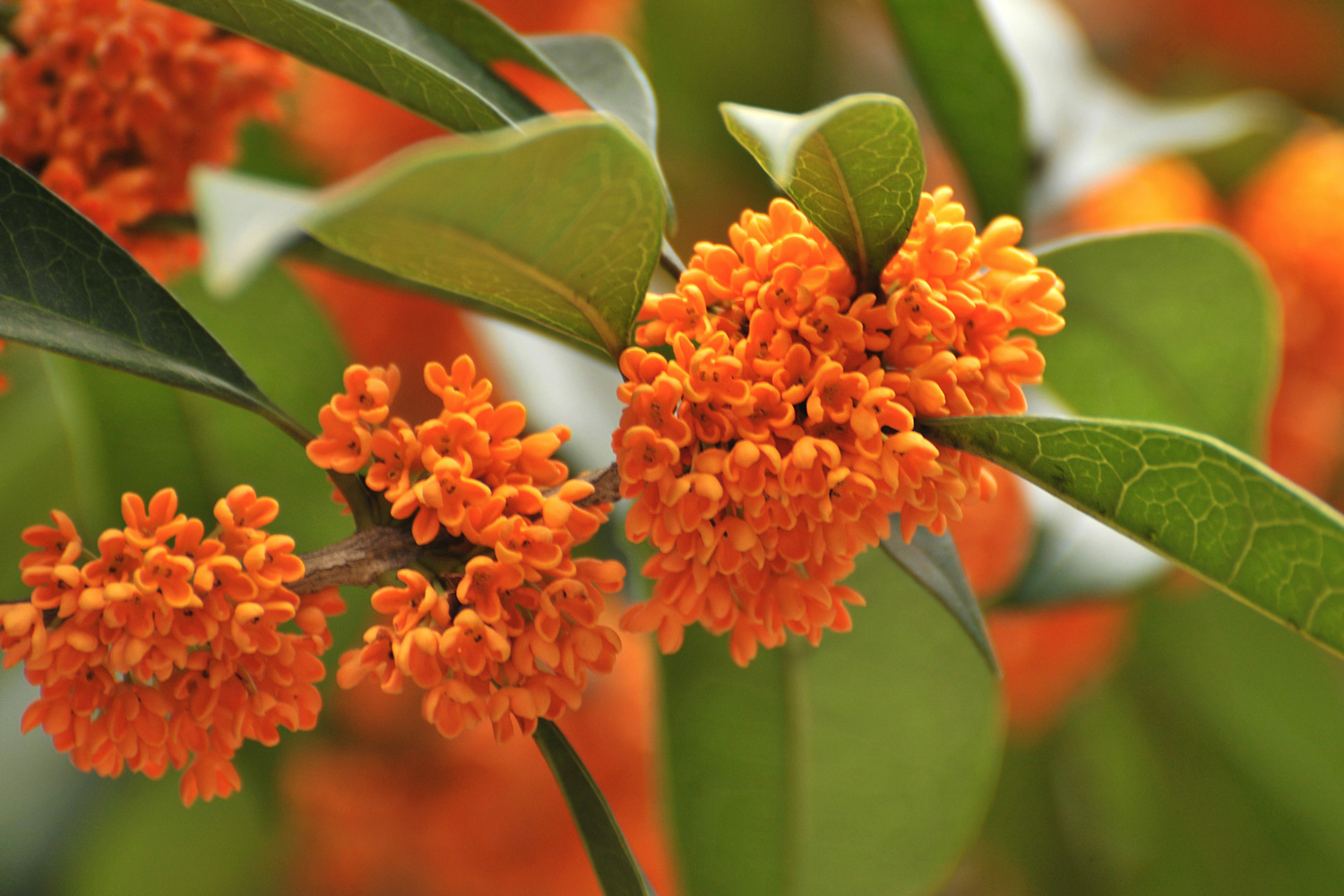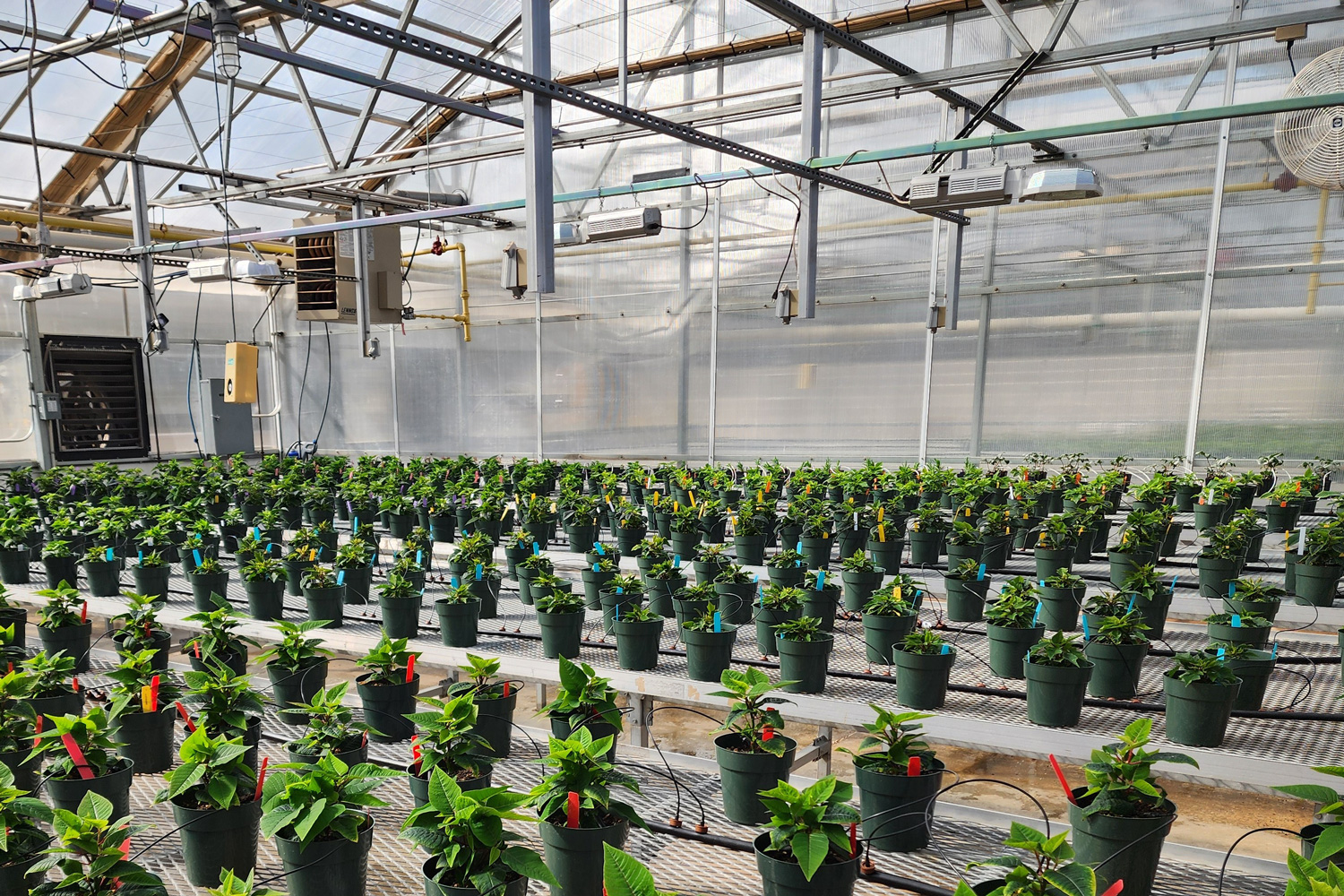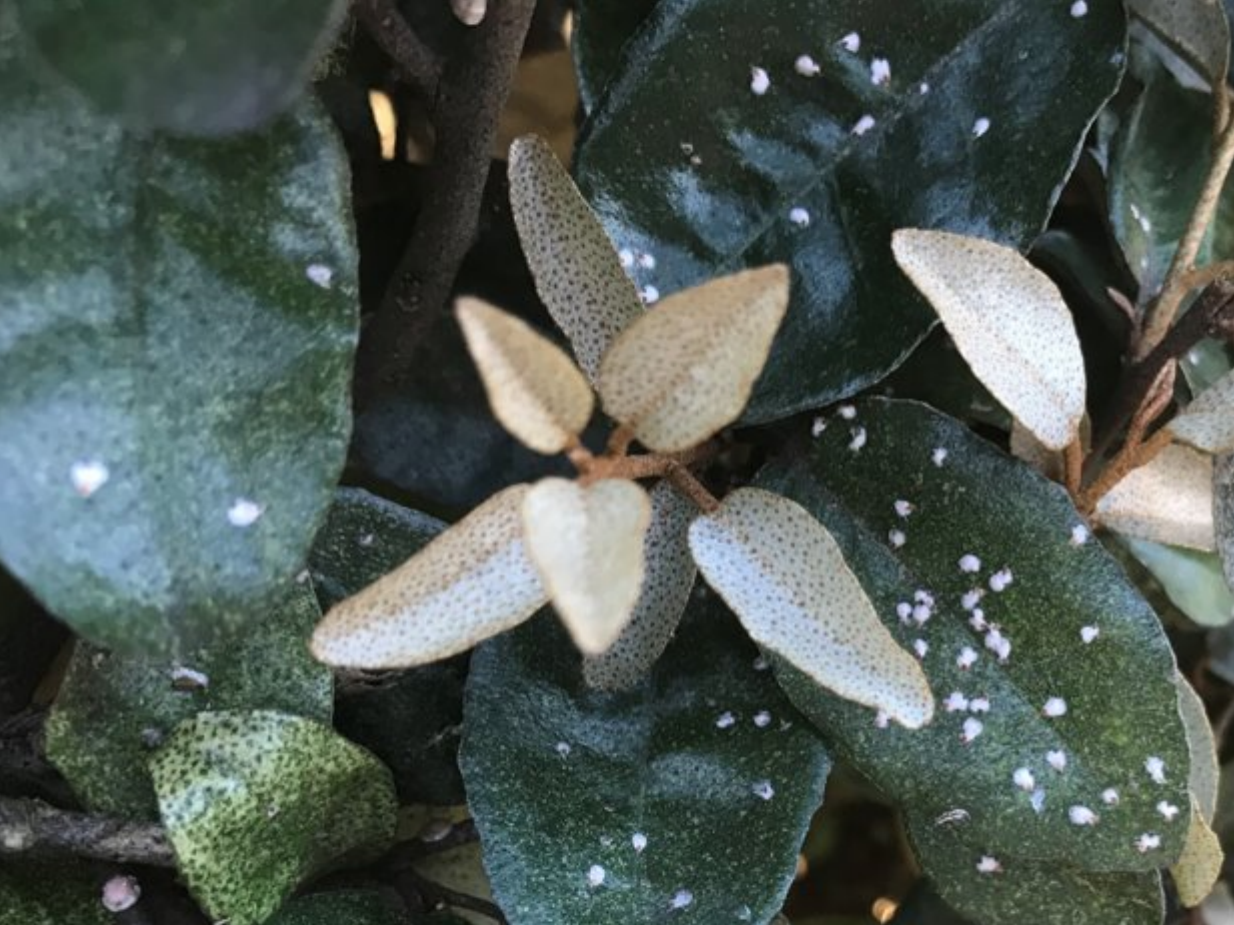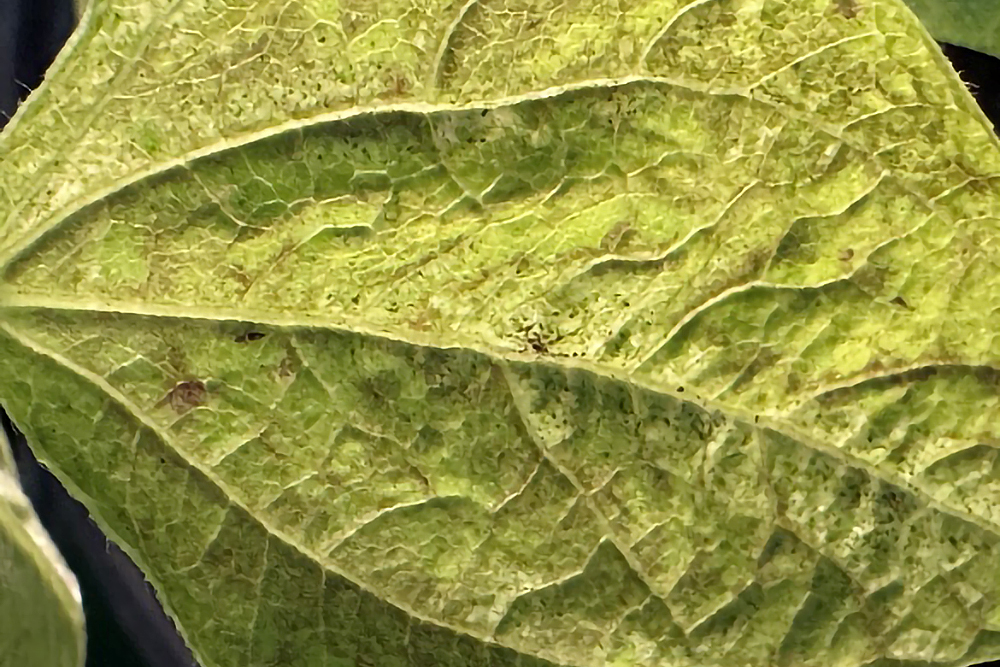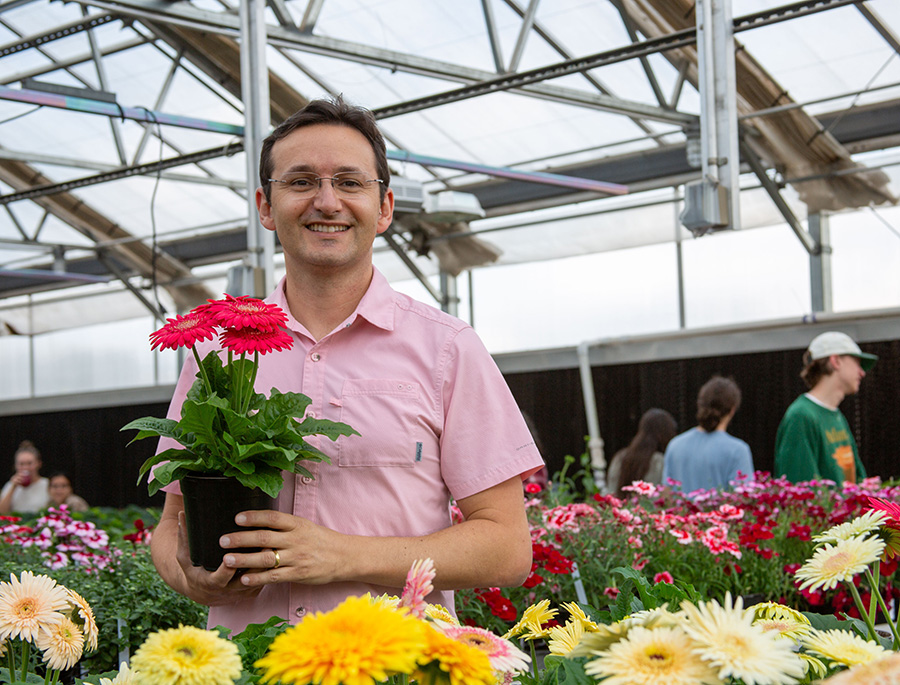Introduction
Sweet tea olives (Osmanthus fragrans Lour.) are woody, evergreen broadleaf shrubs or small trees in the Oleaceae family (He & Shang, 2017). These plants can reach heights of 25 ft but are more commonly observed at 10 to 12 ft high and can be grown in USDA hardiness zones 7b through 9b (Gilman & Watson, 2019).
More than 160 cultivars of O. fragrans have been classified into four groups based on phenotypes (observable characteristsics), such as flower color and blooming season. These are:
- Yingui group (Albus group), which has white to pale yellow flowers that bloom only once in autumn (Figure 1).
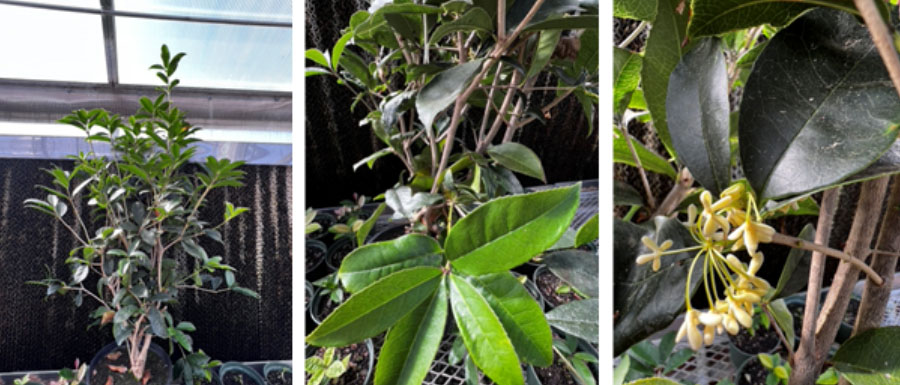
- Jingui group (Luteus group), which has yellow flowers that bloom only once in autumn (Figure 2).
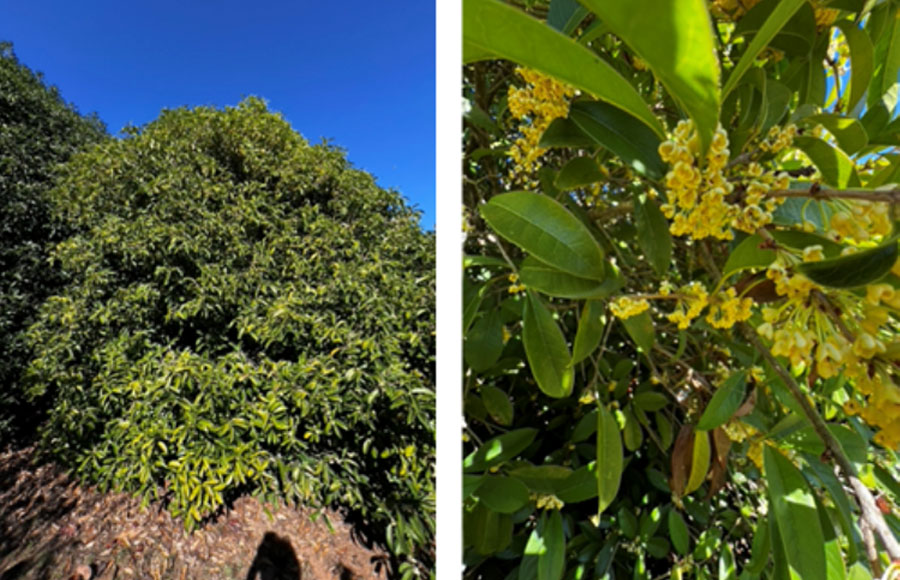
- Dangui group (Aurantiacus group), which has orange flowers that bloom only in autumn (Figure 3).

- Sijigui group (Asiaticus group), which has pale yellow to yellow flowers that bloom several times from fall to spring (Figure 4; Gilman & Watson, 2019; Xin et al., 2013; Xu et al., 2014).
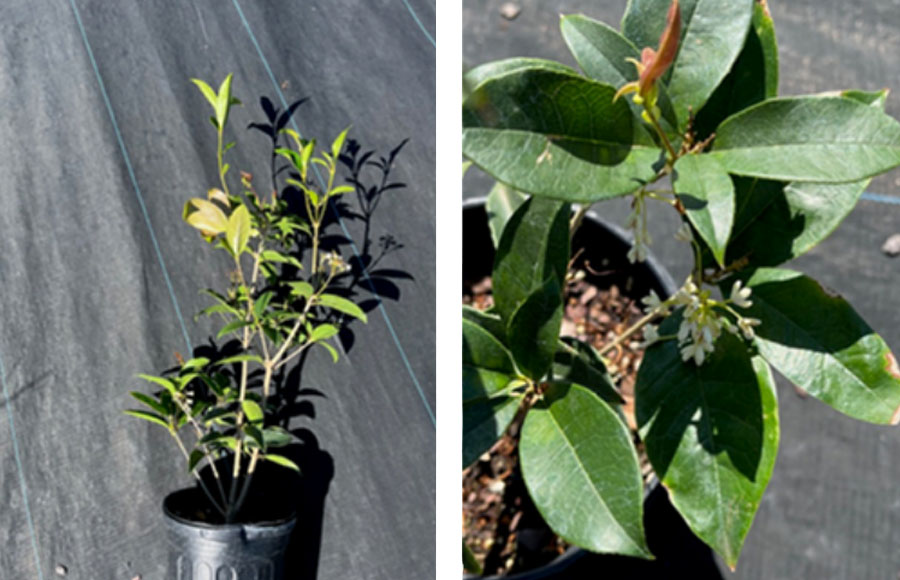
Softwood Cutting Propagation
Softwood cuttings are collected from the soft and new growth shoots of O. fragrans, which have just begun to mature. Different cultivars, hormone rates, and types affect softwood O. fragrans propagation.
For instance, the O. fragrans ‘Cai Ye Gui’ softwood cuttings had slightly lower rooting rates (71.4%) than O. fragrans (78.2%) when treated with 125 mg/L 1-naphthaleneacetic acid (NAA). Additionally, both O. fragrans ‘Cai Ye Gui’ and O. fragrans treated with 100 mg/L NAA had higher rooting rates (90.2% and 91.7%, respectively) than the control (27.9% and 26.1%, respectively).
When treated with ABT1 talc powder (a.i. 30% indole-3-acetic acid [IAA] and 20% NAA), the O. fragrans ‘Cai Ye Gui’ had lower rooting rates than those treated with 100 mg/L NAA (Tong et al., 2018). Similarly, O. fragrans softwood cuttings treated with 100 mg/L NAA had higher rooting rates (61.1%) and more roots (9.23) than those treated with 100 mg/L Indole-3-butyric acid (IBA, 58.43% and 5.47 respectively) and the control (11.10 % and 5.13, respectively).
Softwood cuttings treated with 200 mg/L NAA had higher rooting rates (73.37%) than those treated with 100 mg/L NAA (61.10%), while 200 mg/L IBA-treated softwood cuttings had lower rooting rates (46.67%) than those treated with 100 mg/L IBA (58.43%; Zou et al., 2022).
Timing: Take cuttings in late spring to early summer when new growth is soft and flexible.
Process: Cut current-year growth, using nonwoody stems that are 4 to 6 in. (10–15 cm) long, and leave the top one or two leaves and two to three nodes on the stems. The cut bases are dipped into auxin-based rooting hormones (IBA or NAA) to promote root initiation.
Advantages: Softwood cuttings root faster than hardwood cuttings.
Challenges: This method requires precise temperature and humidity control during rooting.
Semi-Hardwood Cutting Propagation
Semi-hardwood cuttings are taken from the current growth shoots after partial maturation, when the wood is firm, and all leaves are at their full size. Several studies have evaluated hormone rates and types for semi-hardwood O. fragrans propagation. Based on the existing data, different hormone rates and types did not affect the propagation of semi-hardwood O. fragrans. For instance, cuttings of O. fragrans ‘Cai Ye Gui’ treated with 1500 mg/L NAA had a similar rooting rate (81.1%) to those treated with 1500 mg/L IBA (86.4%) (Tong et al., 2018).
Timing: Take cuttings in late summer to early autumn.
Process: Use stems that are partially mature, changing color from green to brown or gray, and exhibiting a firm texture. Stems are cut into 2- to 2.5-in. (5- to 6-cm) lengths, with the top two partially trimmed leaves left in place. The cuttings need to be covered with a misting system to maintain high humidity (85%–95%).
Advantages: Semi-hardwood cuttings are easier to handle than softwood cuttings and are more tolerant.
Challenges: They root more slowly compared to softwood cuttings, but also have a higher success rate.
Hardwood Cutting Propagation
Hardwood cuttings are taken from shoots that have fully matured (normally from August to November, depending on location and weather conditions). The stem is firm and hard to bend. There are a few studies that have evaluated hormone rates and types on hardwood O. fragrans propagation. One of our propagation studies showed that different hormone rates and types did not affect hardwood O. fragrans propagation.
Timing: Take cuttings in late autumn to early winter when plants are dormant.
Process: Select stems that are mature with brown or grey color and exhibit a firm texture. Stems are cut 2 to 2.5 in. (5 to 6 cm) long, with the top two partially trimmed leaves remaining. They need to be covered with a misting system to maintain high humidity (85%–95%).
Advantages: Hardwood cuttings are easier to cut and have a higher tolerance.
Challenges: They are slow-rooting and require a higher concentration of rooting hormone.
Air Layering Propagation
Air layering is a propagation method to produce roots on the stem of a woody plant, allowing you to root branches while they are attached to the parent plant. Air layering is mainly used to propagate plants that are difficult to propagate through cuttings.
Because most O. fragrans are relatively easy to propagate by cuttings compared to other hard-to-root plants, air layering is not commonly used for O. fragrans. However, it can work well for fruit trees and some woody ornamental plants, such as magnolia, holly, camellia, etc.
Timing: Air layering should be started in late spring to early summer for the best results.
Process: Choose a healthy, semi-hardwood branch and strip the bark from a 3/8- to 3/4-in.-wide (1 to 2 cm) ring around the branch, located 12–20 in. (30–50 cm) from the tip, exposing the cambium layer. Wrap the injured area with moist sphagnum moss, cover it with plastic wrap, and securely seal both ends. After the new plant is cut from the mother plant, keep it in a shaded area until it becomes well-established.
Advantages: Air layering has a high success rate with mature plants and is easy to perform.
Challenges: This process requires a few months for rooting to take place.
Seed Propagation
Seed propagation is a sexual propagation method that is widely used for many plants; basically, new plants are produced from a seed. Many common annual and perennial flowers are propagated from seeds, such as petunias, marigolds, zinnias, coneflowers, foxglove, sage, and phlox.
However, seed propagation is less commonly used for O. fragrans because of its low success rate and the unstable features of the offspring. There are a few studies that have reported successful propagation of O. fragrans seeds.
Timing: Fresh seeds are collected in autumn.
Process: Soak the seeds in warm water for 24 hr to break dormancy. Sow them in a well-drained seed-starting mix, keeping the environment warm and humid.
Advantages: Seed propagation allows for genetic diversity among plants.
Challenges: Plants from seed are slow to grow and have a low germination rate, with seedlings taking several years to flower.
Grafting
Grafting is a propagation method that attaches the shoot or bud of one plant, normally called a scion, to the root system of another plant, normally called stock. Grafting is used as a last resort to clonally propagate plants that can’t be propagated through usual means—rooting, budding, seed propagation, etc.—or for plants where a property of the rootstock is vital, such as vigor or disease and nematode resistance.
Grafting is more commonly used in fruit trees such as apples, cherries, citrus, and blueberries, and it also used in some ornamental plants such as roses, cacti, Japanese maples, redbud, etc. However, grafting is rarely used in O. fragrans as it is relatively straightforward to root from stem cuttings.
Timing: Perform cleft and whip grafting in early spring, or T-budding in late summer.
Process: Select a healthy seedling or a well-developed rootstock as the base plant and then take a vigorous scion from a desirable parent plant. During the grafting process, ensure that the cambium layers of the scion and rootstock are precisely aligned to promote successful fusion.
Common methods include cleft grafting, whip and tongue grafting, or T-budding, depending on the season and the size of the materials. Once joined, secure the grafted area tightly with grafting tape or plastic film to prevent moisture loss and infection.
After grafting, place the plant in a shaded, humid environment and maintain consistent moisture in the soil. Once the scion sprouts, remove any unwanted shoots from the rootstock to concentrate nutrients in the desirable part of the plant and promote healthy growth.
Advantages: Grafting preserves the scion cultivar’s traits, and a rootstock can increase a plant’s hardiness and vigor.
Challenges: Successful grafting requires skill, and there are seasonal limitations.
References
Gilman, E. F., & Watson, D. G. (2019). Osmanthus fragrans: Sweet osmanthus (Publication ENH-584). UF-IFAS Extension.
Tong, T., Shao, L., Peng, Z., & Sun, Y. (2018). Osmanthus fragrans ‘Cai Ye Gui’, a variegated cultivar. HortScience, 53(5), 729–731. https://doi.org/10.21273/HORTSCI12770-17
Xin, H., Wu, B., Zhang, H., Wang, C., Li, J., Yang, B., & Li, S. (2013). Characterization of volatile compounds in flowers from four groups of sweet osmanthus (Osmanthus fragrans) cultivars. Canadian Journal of Plant Science, 93(5), 923–931. https://doi.org/10.4141/cjps2012-333
Xu, Y.-C., Zhou, L.-H., Hu, S.-Q., Hao, R.-M., Huang, C.-j., & Zhao, H.-B. (2014). The differentiation and development of pistils of hermaphrodites and pistillodes of males in androdioecious Osmanthus fragrans L. and implications for the evolution to androdioecy. Plant systematics and evolution, 300, 843–849. https://doi.org/10.1007/s00606-013-0923-6
Zou, H., Yan, Z., Cheng, M., Xu, C., Liu, Y., & Zou, N. (2022). Effects of different treatments on softwood cutting survival and rooting of Osmanthus fragrans. Forest Engineering, 38(3), 1–7. https://doi.org/10.16270/j.cnki.slgc.2022.03.001
